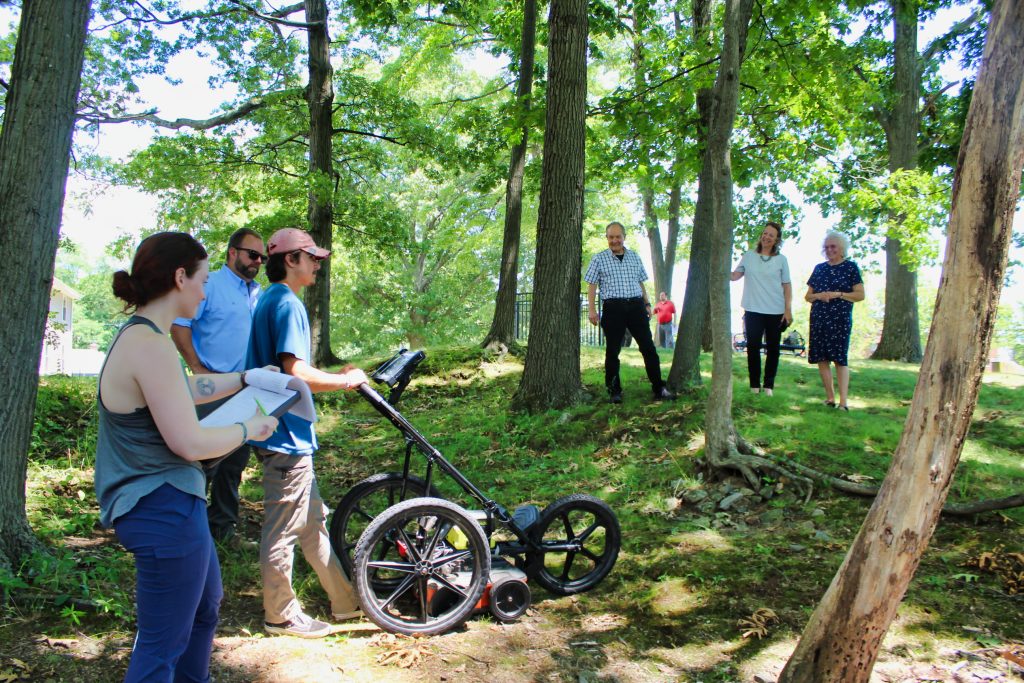
By Michael P. Walsh
Special to the Voice
A state-contracted archaeologist and his two-person team used a ground-penetrating radar on July 2 to determine if the centuries-old remains of British Adjutant William Campbell are buried in a hollow on “Monument Path” near Wade Street in the city’s Allingtown neighborhood.
David E. Leslie, the principal of TerraSearch Geophysical LLC of Berlin, used the radar, which resembles a baby stroller, to scan the wooded path for Campbell’s remains.
Geophysical specialist Fiona Jones and summer intern Ayden Child took turns pushing the GPR back and forth and collecting data as Mayor Dorinda Borer and West Haven Historical Society President Susan Walker gazed intently at the team’s painstaking survey of the grounds.
Borer and Walker were joined by retired city Human Resources Commissioner Beth A. Sabo and author Peter J. Malia, a native of West Haven and an authority on the community’s history.
Nearly 245 years to the day, Campbell, a Scotsman serving in the British army, died hours after saving the Rev. Noah Williston of West Haven’s First Congregational Church from certain death at the hands of British soldiers and Hessian Jager mercenaries during the British invasion of Colonial New Haven.
On the sultry morning of July 5, 1779, the British army invaded New Haven Harbor in an amphibious assault from a fleet of 48 ships, with 1,500 troops coming ashore at West Haven’s “Old Field” under Maj. Gen. George Garth and 1,100 troops landing in East Haven under Maj. Gen. William Tryon.
The survey work is being funded by a $5,000 nonmatching grant from the State Historic Preservation Office, said Sabo, now a volunteer in the mayor’s office who is coordinating the effort for the city.
The high-tech GPR technology helps archeologists uncover buried artifacts without breaking through soil, said Leslie, who has a doctorate in anthropology and is a research scientist at the University of Connecticut Department of Anthropology.
Leslie said preliminary results from his team’s three-day radar and metal detection scans are forthcoming.
“Anything that’s found would be huge,” Sabo said.
If Campbell’s remains are detected, Borer said she’ll commission an archeological dig, most likely conducted by experts from Southern Connecticut State University.
The sliver of property is owned by the Historical Society and is maintained by the University of New Haven, which skirts the burial site.
On June 8, 2023, Campbell descendants George F. Campbell, then 70, and his daughter, Miriam Campbell, then 17, of the Pollokshields suburb of Glasgow, Scotland, paid their respects at the final resting place of their revered fifth- and sixth-generation grandfather at the summit of Monument Path, just off the north side of Route 1 and up the hill from the hollow.
According to a mayoral proclamation presented to the Campbells in June 2023: “William Campbell is one of the first true ‘American’ heroes and is revered by West Haven. To this day, the adjutant is the only known enemy combatant recognized by the very American town he invaded with both a monument and principal avenue named in his honor. Campbell Avenue runs through the heart of our community and has been a vital commercial and transportation artery since it was christened by townspeople in 1874.”
As Leslie’s team scanned for any anomalies in the ground, including human remains, Malia talked about the invasion and some of the actions that occurred on that fateful day.
“We’re not only known as a city of rich history but as a city of rich historians who have the knowledge to share the story of West Haven with future generations,” Borer said.
Hours after sparing Williston’s life, Campbell was shot in the chest atop Milford Hill in present-day Allingtown on his way to New Haven by a local farmer turned defender, according to Malia.
According to oral traditional, Campbell’s body was wrapped in a blanket, placed on a sheep rack, and transported to a hastily dug grave on the north side of the Post Road in a hollow by the edge of the woods. An adjacent strip of land was donated by resident John Prudden.
In October 1831, a small stone bearing the inscription “Campbell, 1779” was erected by resident John Warner Barber to mark the adjutant’s approximate gravesite, but it was destroyed by vandals on Oct. 22, 1872.
The stone was followed by the existing memorial to Campbell, a gray granite monument that was erected by the New Haven Colony Historical Society on July 4, 1891.
The memorial is surrounded by a black wrought-iron fence and is adorned with a wreath and a Union Jack, the national flag of the United Kingdom. The path is bordered by a stone wall.
There is also a small memorial to Campbell on the northwest corner of the West Haven Green. Oddly, the memorial is simply an unmarked stone that is about 80% buried in the ground. I have visited the stone once,